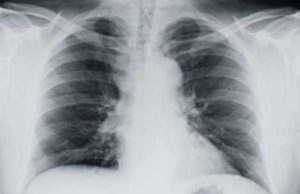
Who is Most at Risk of Developing Mesothelioma Cancer?
Mesothelioma Explained:
Mesothelioma is a unique type of cancer that develops from the transformation of cells in the mesothelium, the two-layered membrane that protects the lungs, abdomen and heart. Each of the three forms of malignant mesothelioma form from prolonged exposure to asbestos; therefore, individuals who have an extended history of dealing with asbestos fibers are at significant risk of developing mesothelioma cancer.
When inhaled, asbestos filaments adhere to the mesothelium; the carcinogens develop tumors which are susceptible to rapid proliferation. The destruction of tissues leads yields metastastization to remote sites, including vital organs. At this stage, mesothelioma cancer is deemed inoperable.
When left alone, asbestos does not pose a risk to human beings; however, when the mineral is disturbed or touched, carcinogenic dust becomes airborne. If chronically inhaled, the probability of developing mesothelioma greatly increases.
Although mesothelioma is rare (roughly 2,000-3,000 mesothelioma cases are diagnosed per year), the disease quite common in the automotive, ship-building and construction industries.
Most forms of mesothelioma form in the lining of the lungs or abdomen cavity. Common symptoms include: night sweats, difficulty swallowing, painful breathing, bowel obstruction, pleural effusion (build-up of fluids in the pleural cavity) a painful and persistent cough, horrible chest pains and unexpected weight loss.
Malignant mesothelioma is extremely difficult to detect in its earliest stages. Complications stem from the cancer’s slow-developing nature and innocent cellular structure. Symptoms will not be present in the majority of malignant mesothelioma cases until 25-50 years following the patient’s first exposure to asbestos.
Treatment options for mesothelioma cancer are dependent on the progression of the disease at the time of diagnosis. The stage of the cancer represents its degree of proliferation; mesothelioma, in its final stage, metastasizes to a number of organs and areas beyond the tumor’s origin point.
Because of a delayed diagnosis, malignant mesothelioma’s prognosis is bleak; the median mesothelioma life expectancy is on, average, 4 to 18 months.
Mesothelioma cancer may be observed in three different types: pleural, peritoneum and pericardial. The most common form, known as pleural effusion, attacks the pleural cavity, the thin layer of lubricating cells that lies between the chest cavity and lungs; Pericardium mesothelioma, which develops in the layer of tissues that lines the lungs; and peritoneum mesothelioma, which destroys the tissues surrounding the abdomen (the peritoneum).
Treatment methods for mesothelioma cancer are elastic to the stage that the cancer was formally diagnosed in. Details concerning mesothelioma stages are as follows:
Stage I Mesothelioma: At its infancy, mesothelioma cancer features a localized tumor that may be located in the lining of the lungs, the diaphragm or the sac surrounding the heart. Formal diagnosis at this stage is exceptionally rare. Individuals lucky enough to secure a 1st stage diagnosis are often eligible for curative mesothelioma surgeries. Said surgeries attempt to extract cancerous tumors from the body.
Stage II Mesothelioma: At Stage II, the mesothelioma proliferates past the point of origin. The cancer at this stage may spread to the lymph nodes or chest wall. Although curative treatment options may be applied in this stage; however, life expectancy is greatly decreased in Stage II patients.
Stage III Mesothelioma: In this stage the cancer produces tangible symptoms. Because of this, diagnosis is most common in stage III. Stage III mesothelioma cancer typically features proliferation to the mediastinum, the lining of the peritoneum, the heart or to the chest wall and/or diaphragm. Patients with stage III mesothelioma face a brutal prognosis. The limited life expectancy attached to the disease warrants only palliative treatment options. The disease is not curable at this stage. Palliative treatment methods are undertaken to bolster the patient’s quality of life by easing the associated symptoms.
Stage IV Mesothelioma: The final stage of mesothelioma cancer features widespread proliferation to remote locations of the body. Because of metastasization, Stage IV mesothelioma is inoperable. Stage IV mesothelioma symptoms are extremely painful. Similar to stage III mesothelioma cancer only palliative treatment options are available for stage IV sufferers. Median life expectancy for stage IV patients is just 4 to 18 months.
If you or a loved one has a prolonged history of asbestos exposure, you must immediately schedule a physical. An appointment is necessary to secure an early stage diagnosis. A physician, in response to hearing of your past dealings with asbestos, will invariably order imaging tests, such as CT Scans, MRI’s and a chest X-ray. If these tests reveal any irregularities, the doctor will suggest a biopsy. This test will extract the tissues or cells in question to affirm a mesothelioma diagnosis.
Even if symptoms are not tangible, seeking medical help is a safety precaution that should not be ignored. Diagnostic tests will take pictures of your lungs, protective tissues and abdomen to observe potential irregularities. Remember, early diagnosis is essential for treatment. Although mesothelioma prognosis is often grim, your life can be significantly prolonged if early detection is achieved. Moreover, curative treatment is possible if you detect the cancer during its initial formation.
Who is Most at Risk of Developing Mesothelioma?
As mentioned above, mesothelioma cancer is directly linked to asbestos exposure. Therefore, individuals who have prolonged histories of asbestos exposure are far more likely to contract the disease.
Mesothelioma cancer, which typically attacks the abdomen and lungs, was profoundly uncommon until the commercial and industrial use of asbestos became popular in the 20th century.
Until the 1980s, asbestos could have been found everywhere in businesses and homes. The mineral was also used in thousands of household and industrial products. Work-related exposure to asbestos delivers the most intense levels of exposure; however, significant exposure can occur at home, in public buildings, at your office and because the mineral is naturally occurring, exposure can take place in urban environments that are considered environmentally friendly.
Individuals can be exposed to the fibers by ingesting or inhaling microscopic asbestos dust. These fibers can lodge in the mesothelial lining of several vital organs, including the lungs. Over time, these fibers eventually form cancerous tumors. Mesothelioma cancer may derive from asbestos exposure because:
• The fibers cause mesothelial cells to become inflamed and irritated, which leads to cellular damage, cancer and irreversible scarring
• The fibers traverse into the cells and impact the natural functions of the bodies, ultimately resulting in genetic changes that lead to mesothelium cancer
• The fibers cause the production of tumors and free radicals, which damage DNA and cause healthy bodies to undergo cancerous mutations
• The fibers may trigger cellular production of oncoproteins, which cause the cells to ignore normal function and ignore their natural cellular division restraints
Although exposure to asbestos is the primary cause of the disease, other risk factors are involved in the development of mesothelioma. Other potential risk factors for mesothelioma include:
• Radiation Exposure
• Exposure to non-asbestos mineral fibers, including taconite and erionite
• Genetics
• Severe chest injuries/chronic inflammation
• Exposure to Simian virus 40, which is a common contaminant of polio vaccines that was primarily administered in the 50’s and 60’s
What Occupations and Jobsites Place Their Employees at Risk?
Exposure to asbestos cancer occurs in several different settings, with certain products, occupations, locations and jobsites at a particularly high risk of asbestos exposure. Common products and locations that involve asbestos are outlined below:
Occupations Most Exposed to Asbestos:
The most dangerous occupation regarding asbestos exposure is mining. Although asbestos exposure is no longer mined in the United States, several American miners have suffered from mesothelioma, lung cancer and asbestosis because substances commonly used in mining were covered with asbestos. Contamination was most prevalent in W.R. Grace and Company’s vermiculite mines, located in Libby, Montana. This location featured hundreds of vermiculite miners, precipitating the deaths of hundreds of miners and their family members.
Following mining, exposure to asbestos is most common in “traditional” industries where workers labor in closed quarters and atmospheres that utilize asbestos containing materials. According to several organizations, including the National Institute for Occupational Safety and health, roughly 25 percent of worker deaths caused by asbestos-related disease in the 1990’s were found in the construction industry.
Other hazardous industries that work with asbestos fibers include:
• Railroads
• Industrial and chemical industries
• Boat and Ship building/repairing
• General government positions
• Nonmetallic mineral and stone products
• Electrical power and light industries
• Steelworks, finishing mills and blast furnaces
• Elementary and Secondary schools
Occupations that place workers in danger of high-levels of asbestos exposure include:
• Painters
• Floor Coverers
• Refinery Workers
• Machinists
• Pot Tenders
• Weavers
• Excavators
• Technicians
• Rubber Workers
• Mixing Operatives
• Warehouse Workers
• Brake and Clutch Manufacturers
• Paper Mill Workers
• Tinsmiths
Also, because asbestos was used in the building of destroyers and battleships throughout the 19th and 20th century, a significant number of World War II navy veterans were exposed to abnormal levels of asbestos either as sailors or shipbuilders.
Workers who do not handle asbestos directly but who experienced significant exposure because fibers were either present in the atmosphere or in products with which these individuals commonly contacted are:
• Textile Workers
• Aerospace workers
• Longshoremen
• Building Inspectors
• Automobile mechanics
• Die and Job setters
• Contractors and building managers
• Automobile mechanics
Asbestos in Products:
Throughout the late 19th century, the use of asbestos was popular in the manufacturing and construction industries due to the mineral’s highly durable, versatile, flexible and inexpensive nature. Asbestos also boasts phenomenal insulating properties, which offers manufacturers a way to strengthen products, buildings and protects said products from heat and fire without adding cost or weight.
Until the late 70’s, asbestos was used in thousands of everyday products including, paper goods, engines, military vessels, automobiles, protective clothing and an assortment of household items.
Safety regulations regarding the use of asbestos in products first surfaced in the 70’s and 80’s. In 1977, the United States Consumer Product Safety Commission formally prohibited the use of asbestos patching materials and artificial ash products that were common in household fireplaces. Then, in July of 1989, the United States Environmental Protection Agency issued a formal ban of most asbestos-containing products; however, this ruling was overturned by several local courts. Currently, the EPA ban affects only roll-board, flooring felt and specific types of papers that contain asbestos filaments.
Presently, there are thousands of construction materials and products that contain asbestos. Because of its widespread use, it is crucial to be aware of the risks of mesothelioma, lung cancer and other life-altering conditions associated with ingesting or inhaling airborne asbestos fibers.





























